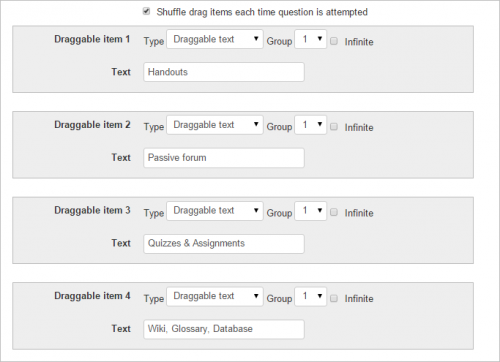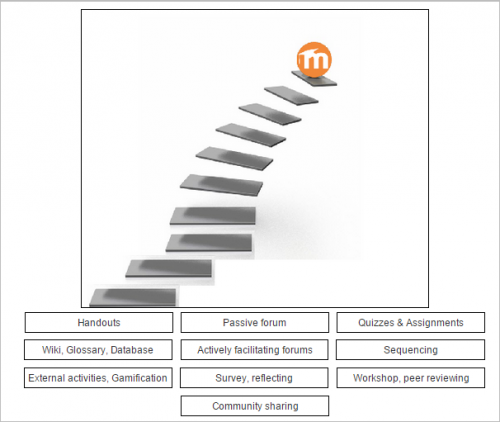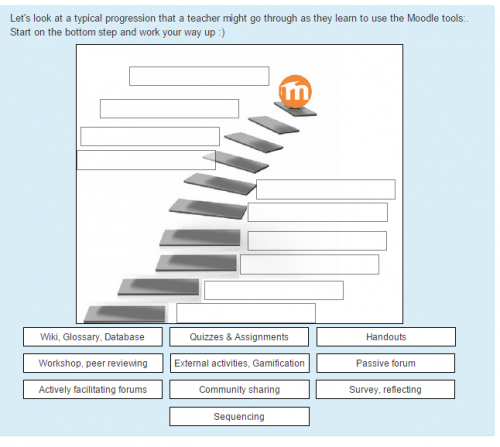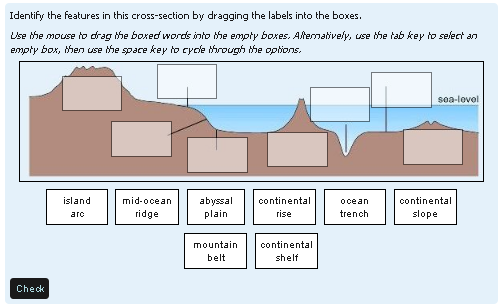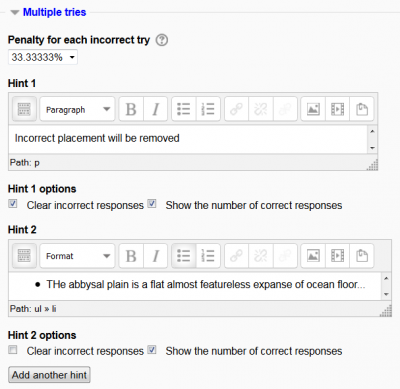Drag and drop onto image question type: Difference between revisions
- Managing questions
- Question behaviours
- Question types
- Calculated
- Simple Calculated
- Drag and drop into text
- Drag and drop markers
- Drag and drop onto image
- Calculated Multichoice
- Description
- Essay
- Matching
- Embedded Answers (Cloze)
- Multiple Choice
- Random Short Answer Matching
- Select missing words
- Short-Answer
- Numerical
- True/False
- Third-party question types
- Questions FAQ
Mary Cooch (talk | contribs) (WIP) |
Mary Cooch (talk | contribs) |
||
| Line 16: | Line 16: | ||
===Example one=== | ===Example one=== | ||
*''Based on the Moodle documentation [[Pedagogy]], participants must 'climb the Moodle ladder' by ordering the stages of using Moodle as a teacher.'' | *''Based on the Moodle documentation '''[[Pedagogy]]''', participants must 'climb the Moodle ladder' by ordering the stages of using Moodle as a teacher.'' | ||
*In the '''Preview''' section, a basic image of steps is uploaded | *In the '''Preview''' section, a basic image of steps is uploaded | ||
*In the '''Draggable items''' section, the 'type' is chosen as 'draggable text' and the text for each stage is added. (Groups and the infinite setting are not used in this example) | *In the '''Draggable items''' section, the 'type' is chosen as 'draggable text' and the text for each stage is added. (Groups and the infinite setting are not used in this example) | ||
Revision as of 18:11, 30 September 2015
This page is about the drag and drop into image question type, which is a popular form of 'selection' question consisting of images or words which can be dragged from a list and dropped into pre-defined gaps on the base image.
This is a question type created and maintained by the Open University and is available from the Moodle plugins database
How to create a question
- Give the question a descriptive name to help you find it in the question bank. (Students won't see the name.)
- Add the question to the text editor, using any formatting you wish.
- In the Preview section, click the background image button to upload an image. Larger images will be displayed at a maxiumum 600 x 400.Your image will then display under the file upload box.
- In the Draggable items section, you can upload images if you leave the type as 'draggable image' or you can type in words if you change the type to 'draggable text'. You may have a mixture of images and text.
- In the Drop zones section, you choose which items to go in which zone.
- You can then position the items on the background image and this will add their coordinates.
- Note:(1) if you use images, their size will be resized to....
- Note (2) You can format draggable text using <sub>, <sup>, <b>, <i>, <em>, <strong> and <br/>
- Note (3) Choices that are within the same Group are colour coded and may only be dropped on a drop zone with the corresponding colour. Choices that are marked as 'infinite' may be used in multiple locations.
Example one
- Based on the Moodle documentation Pedagogy, participants must 'climb the Moodle ladder' by ordering the stages of using Moodle as a teacher.
- In the Preview section, a basic image of steps is uploaded
- In the Draggable items section, the 'type' is chosen as 'draggable text' and the text for each stage is added. (Groups and the infinite setting are not used in this example)
- In the Drop zones section, an item from the previously added options is chosen from the drop down:
- These texts will now appear under the background image:
- The text boxes are dragged to their correct positions on the image (steps on the staircase) This will then add the co-ordinates to the Dropzones section automatically:
- Other settings are completed (see below) and the question is saved.
- Participants must drag the Moodle stages to the correct step:
Example two
- Participants must add the correct country flag and capital city onto a map of Europe.
- This question has images as well as text and makes use of the Groups feature.
- In the Preview section, a basic map of Europ is uploaded.
- In the *In the Draggable items section, the capital cities are added as the type 'draggable text' and the flags are added as the type "draggable image"
The drag item will be placed at the top and left coordinates as measured in pixels from the top left of the background image.
Within draggable text items limited formatting of text using <sub>, <sup>, <b>, <i>, <em> and <strong> is allowed. <br/> is also allowed.
Choices that are within the same Group are colour coded and may only be dropped on a drop zone with the corresponding colour. Choices that are marked as 'infinite' may be used in multiple locations.
The resulting question when run in 'interactive with multiple tries' style looks as follows:
Accesibility
Drag and drop questions are keyboard accessible. Use the <tab> key to move between the drop zones and the <space> key to cycle around the possible choices for each drop zone.
Scoring
All gaps are weighted identically and in the above example each drop zone is worth 12.5% of the marks. Only drop zones that are filled correctly gain marks. There is no negative marking of drop zones that are filled incorrectly.
Whether or not Combined feedback is shown to students is governed by the Specific feedback setting on the iCMA definition form.
Penalty for each incorrect try: The available mark is reduced by the penalty for second and subsequent tries. In the example above a correct answer at the second try will score 0.6666667 of the available marks and a correct answer at the third try will score 0.3333334 of the available marks.
If the question is used in 'interactive with multiple tries' behaviour the marking is modified as follows:
- The mark is reduced for each try by the penalty factor.
- Allowance is made for when a correct choice is first chosen providing it remains chosen in subsequent tries.
Hint: You can complete as many of these boxes as you wish. If you wish to give the student three tries at a question you will need to provide two hints. At runtime when the hints are exhausted the question will finish and the student will be given the general feedback and the question score will be calculated.
Clear incorrect responses: When ‘Try again’ is clicked incorrect choices are cleared.
Show the number of correct responses: Include in the feedback a statement of how many choices are correct.
See also
The original documentation page at the Open University site.
